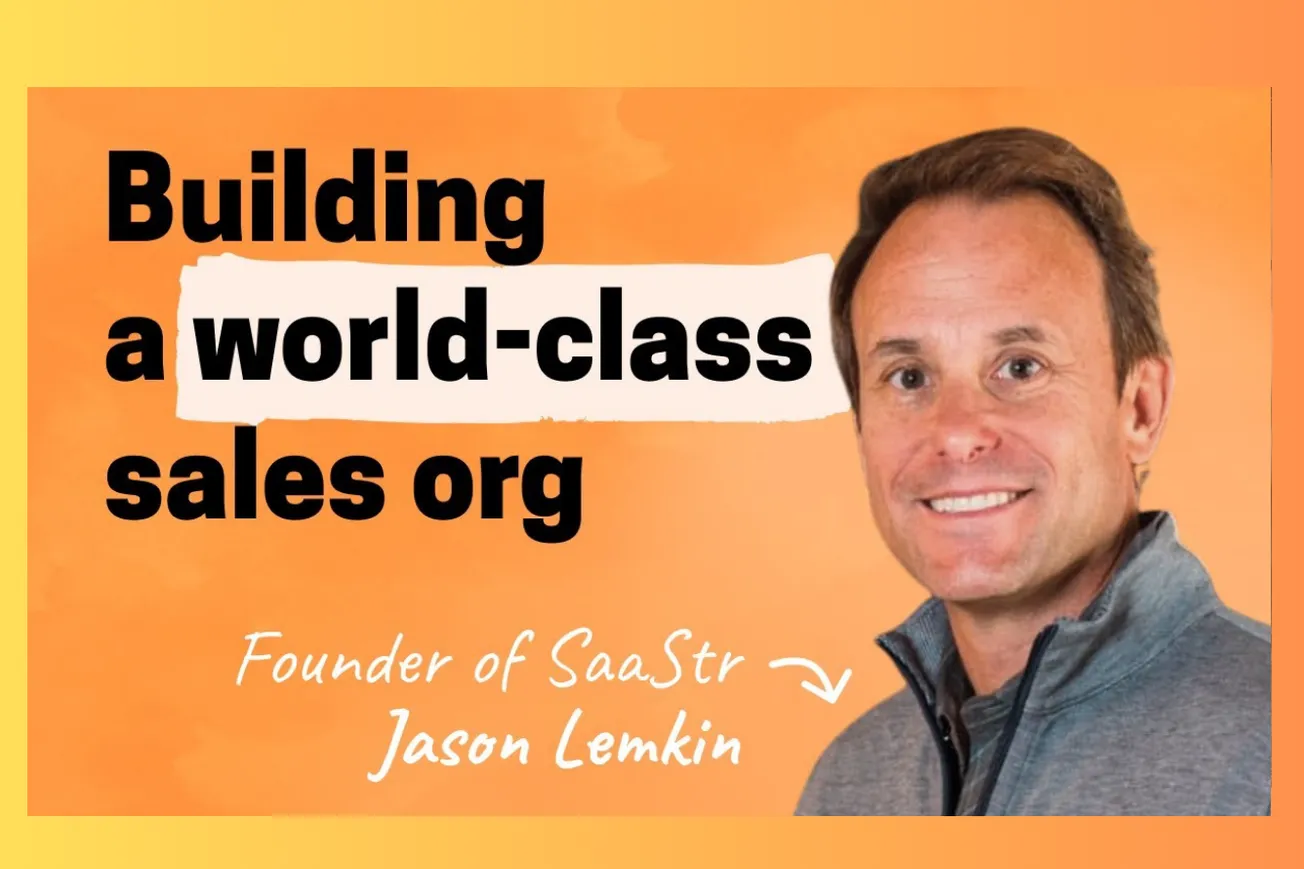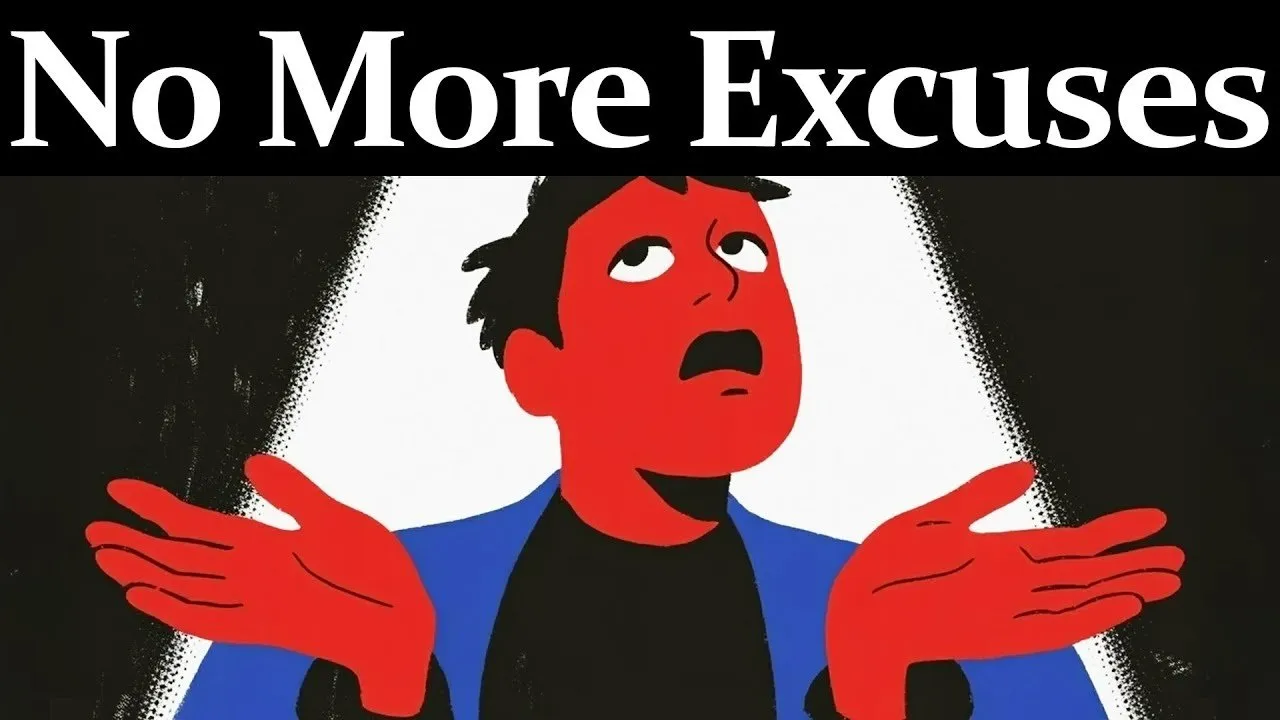Table of Contents
Learn from the SaaStr founder's decade of experience scaling sales teams from zero to hundreds of millions in ARR.
Key Takeaways
- Most B2B companies will eventually need sales teams regardless of initial self-serve aspirations
- Hire two sales reps simultaneously, not one, to enable proper A/B testing of human talent
- The best early sales hires are people you would personally buy your product from
- VP of Sales should only be hired after you have two reps consistently hitting quota
- Early sales reps need product expertise; later hires need process management skills
- Sales compensation should start with 100% commission for first quarter to build momentum
- Product leaders must be deeply involved in sales calls for complex B2B deals
- Give sales teams quarterly budgets for feature requests to prevent constant disruption
- The "rules of eight" govern sales team scaling: eight reports per manager at every level
Timeline Overview
- 00:00–06:18 — Jason's Background and SaaStr Foundation: Building the world's largest B2B community, selling EchoSign to Adobe, and creating conferences that attract 15,000+ attendees annually
- 06:18–11:23 — The Importance of Sales in B2B Businesses: Why every B2B company eventually needs sales, the self-serve vs sales-led decision framework, and tragic examples of companies that fired sales teams
- 11:23–14:19 — Signs That You Should Start Hiring Salespeople: The 20% time threshold rule, why founders must close first 10 customers personally, and the critical transition from founder-led to rep-led sales
- 14:19–19:08 — Attributes to Look for in Early Sales Reps: The "would you buy from them" test, why you need quirky pirates and romantics, and the importance of interviewing 30 candidates
- 19:08–26:43 — Hiring a VP of Sales: Why hiring VPs before having two successful reps leads to 100% failure rate, the stretch candidate principle, and timing the transition from 3 to 300 reps
- 26:43–30:06 — The Role of a VP of Sales: Why VPs must carry a bag in today's environment, the burnout epidemic among sales veterans, and identifying leaders who still want to sell
- 30:06–45:16 — Interviewing Salespeople: The "what do you want to do your first 14 days" test, the sell-me-this-pen requirement, and why reference checks have disappeared post-2020
- 45:16–53:34 — Determining Sales Compensation and Quota: The 50/50 base/bonus split, why reps should make 4-5x their compensation in revenue, and structuring first-quarter success
- 53:34–56:58 — Transitioning from 100% Commission: When to normalize compensation structure, the danger of keeping things too easy, and why fewer better reps beats more struggling reps
- 56:58–59:39 — Indicators of Hard-to-Sell Products: Why hiring from "harder to sell" products creates better reps, the technical complexity challenge, and avoiding the number four player curse
- 59:39–01:05:26 — Scaling the Sales Organization: The rules of eight for organizational structure, when stretch VPs break, and the 50% internal promotion principle
- 01:05:26–01:10:02 — Understanding Sales Roles and Titles: SDR vs AE distinctions, why full-stack AEs don't exist in reality, and the missing senior IC track in sales
- 01:10:02–01:20:32 — Product Involvement in Sales and Vice Versa: Why heads of product must join big deals, the quarterly budget system for feature requests, and preventing sales-product tension from breaking organizations
- 01:20:32–01:27:23 — Product Teams Taking P&L Responsibilities: The customer success weaponization warning, dark pattern dangers in PLG, and why customer-centricity matters more than short-term metrics
- 01:27:23–01:31:02 — One Thing Founders Can Do to Become Better at Sales: The critical "next step" skill that separates great salespeople from mediocre ones, and why founders are natural middlers
- 01:31:02–01:39:50 — The Ideal Trial Length and Customer-Centricity: Why 14-day trials often serve sales teams over customers, the power of infinite trials, and being the "VP of free"
- 01:39:50–01:41:43 — Closing Thoughts and Being the Year of Product: Jason's challenge to ship three great things, making customers the center of everything, and why product teams must lead customer advocacy
The Foundation: When B2B Companies Actually Need Sales Teams
Jason's core insight challenges the conventional wisdom around sales necessity in B2B companies. While many founders hope to build purely self-serve businesses, the reality is more nuanced. "If you truly build a self-served product you can either never have a sales team or like slack defer it or like canva really defer it," he explains, noting that Canva didn't build a sales team until well north of $500 million in revenue.
The key lies in honest assessment of your first 10-15 customers. These early adopters reveal your true business model, not your aspirations. If customers need extensive conversations about security, competition, onboarding requirements, or complex deployment scenarios, attempting a self-serve motion becomes a fatal mistake.
Jason shares a devastating example: "A company I invested in 18 months ago when things were easier right maybe 20 months ago they were doing five million in Revenue growing over 100% with the sales life motion things got harder... and they decided to fire the whole sales team and now they're doing less than one from five million today because they fired the sales team because the founders didn't like sales."
The decision framework is straightforward: if your first customers found you organically and completed purchases without human interaction, optimize for viral loops and growth hacking. If they required explanation, demonstration, and relationship-building, embrace the sales-led motion. Fighting your natural customer behavior pattern leads to failure.
Many successful companies operate hybrid models. Even Slack, which started entirely self-served, generated the majority of revenue from enterprise sales by their IPO. The critical insight is sequencing: understand your current DNA, then evolve strategically rather than abandoning what's working because it doesn't match your preferred business model.
The Critical Hiring Framework: Why Two Reps Beat One Every Time
Jason's most counterintuitive advice centers on simultaneous dual hiring. "You've got to hire two because otherwise there's no AB test you have to AB test humans," he emphasizes. This principle stems from the precious nature of early leads and the binary nature of sales success.
The selection criteria is deceptively simple but profound: "Those first couple reps have to be people you would buy your own product from." This test cuts through impressive LinkedIn profiles and industry experience to focus on authentic product understanding and customer empathy.
The hiring process demands significant investment. Founders must interview approximately 30 candidates to find these two gems. "Twenty are just going to break your brain because they don't do any work and they don't do any prep and they didn't even go to your website and then eight of the next 10 are sort of okay but you know it's not really going to work... but if you're lucky one or two of them they're like magicians."
Jason's first hire illustrates this principle perfectly. Despite being let go by a previous startup and living in his brother's garage, this candidate understood the product and market dynamics better than polished competitors from prestigious companies. "He was the only one that I knew could actually that I would buy my product from not that I would buy something from but I would buy my product from."
The timing for these hires follows specific triggers: you've closed your first 10 customers personally, and sales activities consume more than 20% of your time. At this threshold, you need leverage or your calendar becomes unmanageable. These early reps must possess sufficient maturity and experience to handle precious leads without constant oversight, but they don't need traditional sales management backgrounds.
The risk of hiring too early or hiring the wrong profile is catastrophic. Leads are too precious to waste on unproven representatives. "If you hire this perfect person from Snowflake and you have three leads a month and you give him two and he doesn't close them your company's gonna die."
VP of Sales: The Most Dangerous Premature Hire
The VP of Sales hiring mistake represents perhaps the most expensive error early-stage companies make. Jason's rule is absolute: "You need two sales reps hitting quota closing deals before you're ready to hire a manager for them... if you hire it before then you're you're you're doing a hell Mary it ain't going to work it never ever never ever ever never ever Works."
The reasoning reveals the impossible mission created by premature VP hiring. You're asking one person to find product-market fit, be the first rep, be the second rep, and scale the organization simultaneously. "It's mission impossible to do all four at the same time," Jason notes.
The proper sequence follows a clear progression: founder closes first 10 customers, two reps achieve consistent quota attainment, then VP of Sales enters to scale from "rep 3 to 300." VPs excel at taking proven systems and expanding them, not creating systems from scratch.
The ideal VP candidate is typically a "stretch" hire - someone promoted from director level rather than a seasoned VP making their third or fourth VP transition. This ensures hunger, growth mindset, and willingness to do the actual work rather than pure management.
In today's environment, Jason adds a crucial requirement: the VP must carry a bag. "Whether they carry a quota a half quota whether they back fill the sales team you want a salesperson... you want a head of sales that actually wants to do sales." This requirement filters out burned-out veterans who want management roles without sales responsibility.
The test question reveals everything: "What do you want to do your first 30 days?" Wrong answers focus on process, territory planning, or Salesforce optimization. Right answers emphasize customer meetings, deal involvement, and hands-on product learning.
The Art of Sales Interviewing: Beyond Resume Credentials
Jason's interviewing methodology cuts through conventional screening to identify genuine sales talent. The foundation involves a simple but revealing question: "What do you want to do your first 14 days?" This Columbo-style inquiry separates doers from process-focused managers.
For both VP of Sales and VP of Product candidates, Jason looks for the same answer: immediate customer engagement. "Every single great VP product Chief product officer I've ever worked with... you know what the first thing they do in the first two weeks they like leave me alone I'm going to go talk to 20 customers."
The "sell me this pen" requirement has evolved into "sell me this app." Jason doesn't surprise candidates but gives them time to prepare. The shocking reality: "I am shocked how many salespeople I have met from SDR to VP of sales that by the time... they haven't even watched an explainer video yet." This basic preparation test eliminates 98% of applicants.
The deeper purpose tests product comprehension and problem-solving ability. "We're not selling in B2B we're solving problems," Jason explains. Great reps position products like a Tesla Model 3 Performance - acknowledging competition and potential objections while demonstrating superior value through expertise and consultation.
Reference checks, largely abandoned post-2020, must return to hiring processes. The investment in time, money, and opportunity cost of sales hires demands thorough validation. "You're going to invest so much and forget about the salary... your time your leads your everything's so precious" requires comprehensive due diligence.
The interview process should include working sessions where candidates demonstrate actual sales methodology. This practical assessment reveals thinking patterns, preparation habits, and genuine enthusiasm for the product and problem space.
Compensation Architecture: Aligning Incentives for Explosive Growth
Jason's compensation philosophy prioritizes getting reps to profitability quickly while maintaining long-term sustainability. The standard structure follows a 50/50 split between base salary and commission, but implementation requires nuanced understanding of cash flow and motivation psychology.
For first-quarter success, Jason recommends extreme front-loading: "My early early day comp plan is look your first three months you keep 100% of what you close." This approach, combined with base salary, creates powerful momentum while the rep learns the product and market.
The math works because founders often panic about top-line compensation numbers without understanding monthly cash requirements. A $140k OTE actually means $70k base salary, which equals approximately $6k monthly cash outlay for the crucial testing period.
The sustainable model requires reps to generate 4-5x their total compensation in revenue. "Three x for small businesses 4X for mid-market 5x you got to get there but you don't have to be there in day one." This multiple ensures healthy unit economics while rewarding successful reps generously.
Compensation plans should remain stable for years, not constant revision projects. "If you get it right you never have to revisit it not for years." The key insight: reps must eat and feel successful, but they must also generate meaningful profit for the business.
Jason advocates concentrating leads with top performers rather than distributing equally across struggling reps. "I'd much rather have two reps each closing two million than 20 reps struggling to close 100K each." This concentration builds cultural momentum and domain expertise while identifying replicable success patterns.
The transition from 100% commission to normalized structure should happen within one quarter. Extended periods of easy compensation create dependency among mediocre performers and don't help identify mis-hires quickly enough.
Product-Sales Integration: The Strategic Partnership That Drives Growth
The relationship between product and sales teams determines success in complex B2B environments. Jason advocates for deep product involvement in sales processes, particularly for significant deals where product leaders become "like the mini CEO in these meetings."
The value proposition is clear: "If the head of product hadn't been there that deal would have been lost would have been lost an AE doesn't know that even if an AE did know that... even if the VPs sales didn't know a VPS sales would not be empowered enough to stand up in a meeting and say I know what you want we can launch tomorrow on this."
This integration requires product leaders with gravitas, complete product fluency, and authority to make commitments. They must understand how disparate product components connect and have the confidence to adapt solutions for large customer requirements in real-time.
The reverse relationship - sales input into product roadmap - requires structured boundaries to prevent chaos. Jason's solution: quarterly budgets for sales feature requests. "Give your head of sales a certain budget whether it's story points or 10% of the pie chart however you do it give them a budget and when you do this things will radically change."
This system forces prioritization discipline on sales teams who otherwise "change like the wind." Monday's critical HubSpot integration becomes Wednesday's urgent SAP requirement becomes Friday's essential Salesforce update. Budget constraints force load balancing across genuine customer needs rather than reactive decision-making.
The weekly review process keeps both teams aligned: sales reports on current priorities and upcoming quarters, product explains development status and change costs. This creates collaborative planning while maintaining engineering focus and preventing the constant disruption that burns out development teams.
Individual contributor interactions should push decisions upward rather than creating multiple conflicting priorities. "The stress between product and sales is a good thing... if there's no stress you're not in enough deals" but it must be managed through proper organizational structure.
Conclusion
Jason Lemkin's approach to building sales organizations reflects deep understanding of both human psychology and business economics. His framework prioritizes authentic customer relationships over process optimization, strategic patience over reactive hiring, and integrated go-to-market approaches over functional silos.
The meta-lesson underlying all tactical advice is the critical importance of being customer-centric rather than internally focused. Whether designing compensation plans, structuring product roadmaps, or interviewing candidates, the question remains constant: does this serve customers better and create sustainable value for all stakeholders?
This customer-first philosophy becomes especially crucial in challenging market conditions. Rather than weaponizing teams or optimizing for short-term metrics, successful organizations double down on solving real problems for real customers. As Jason challenges: "Ship three great things this year... let's do something that's under our control - the code we write and the product we ship."
Practical Implications
- Start sales hiring when spending 20% of time on sales activities - this ensures sufficient deal flow to keep reps productive while providing necessary leverage for founders
- Interview 30 candidates to find 2 great early reps - the investment in thorough screening pays massive dividends given the precious nature of early leads and high cost of mis-hires
- Test candidates with "sell me this app" assignments - practical demonstrations reveal preparation habits, product comprehension, and genuine sales ability better than resume credentials
- Wait for two quota-hitting reps before hiring VP of Sales - premature VP hiring leads to 100% failure rate because it asks one person to do four impossible jobs simultaneously
- Require VP of Sales to carry a bag in today's market - this filters out burned-out veterans who want management roles without sales responsibility
- Structure first quarter compensation at 100% commission plus base - front-loaded incentives create momentum while reps learn the product and establish success patterns
- Give sales teams quarterly budgets for feature requests - this prevents constant engineering disruption while forcing sales prioritization discipline
- Have product leaders join major sales calls - technical expertise and roadmap authority often determine deal outcomes in complex B2B sales
- Focus on customer-centricity over internal optimization - sustainable growth comes from solving real problems rather than manipulating metrics or processes
- Scale using "rules of eight" organizational structure - eight reports per manager at every level provides optimal span of control and clear promotion pathways





